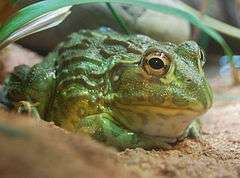African bullfrog
| African bullfrog | |
|---|---|
 | |
| Scientific classification | |
| Kingdom: | Animalia |
| Phylum: | Chordata |
| Class: | Amphibia |
| Order: | Anura |
| Family: | Pyxicephalidae |
| Subfamily: | Pyxicephalinae |
| Genus: | Pyxicephalus |
| Species: | P. adspersus |
| Binomial name | |
| Pyxicephalus adspersus Tschudi, 1838 | |
The African bullfrog (Pyxicephalus adspersus) is a species of frog in the Pyxicephalidae family. It is also known as the pixie frog due to its Latin name. It is found in Angola, Botswana, Kenya, Malawi, Mozambique, Namibia, South Africa, Swaziland, Tanzania, Zambia, Zimbabwe, and possibly Democratic Republic of the Congo.
Its natural habitats are dry savanna, moist savanna, subtropical or tropical dry shrubland, intermittent freshwater lakes, intermittent freshwater marshes, arable land, pastureland, and canals and ditches. It is a large frog, with males weighing 1.4 kg (3.1 lb), though can easily exceed 2 kg (4.4 lb). Females are half the size of males, which is unusual since in most amphibian species females are larger than males. Males can reach 23 cm (9 inches) while females are much smaller.[2][3]
Feeding and habits
The African bullfrog is carnivorous and a voracious eater, eating insects, small rodents, reptiles, small birds and other amphibians.[2] It is also a cannibalistic species — the male African bullfrog is known for occasionally eating the tadpoles he guards.[4] An African bullfrog kept at the Pretoria Zoo in South Africa once ate 17 Juvenile Rinkhals Snakes (Hemachatus haemachatus).[5] They emit a loud croaking and a bleating sound when stressed or handled. Like the Pacman frogs and the Budgett's Frogs, African Bullfrogs also bite when they are provoked. It is one of three frog species that have sharp teeth and bite humans when they are provoked or handled by humans (when they are getting picked up by humans using their hands to lift them up).
Reproduction
Breeding starts after heavy rain (initiated by 65 mm of rain over the previous day or two). They breed in shallow, temporary water bodies, such as pools, pans and ditches. Eggs are laid in the shallow edge of the pond, but fertilization takes place above water level.[6]
The African bullfrog males call out during the rainy season. The call lasts about a second and can be described as a deep low-pitched whoop.[7] Males have two breeding strategies, depending on their age. Young males congregate in a small area, perhaps only 1 or 2 square meters of shallow water. The larger males occupy the center of these breeding arenas or leks and attempt to chase off other males. Often they fight, causing injury and even killing one another. The dominant male attempts to prevent other males from breeding. A female approaches the group of males by swimming along at the surface until she is within a few meters of the group. Then the female dives to avoid the smaller males and surfaces in the defended area of a larger male in the middle of the group. This helps to ensure that she mates with the dominant male.[6]
The female lays about 3,000 to 4,000 eggs at a time. The tadpoles hatch and after two days start feasting on vegetation, small fish, invertebrates and even each other. Defending males will continue to watch over the tadpoles, which will metamorphose within three weeks. During the tadpole's development, the father guards his young. Due to the male bullfrog's overprotective behavior, he will pounce and bite anything that he views as a threat. If the pool is in danger of drying out, the father will use his legs and head to dig a canal from the drying pond to a bigger pond. He will continue to guard the tadpoles until they are old enough to fend for themselves, although he may also eat some of them.[6][8]
In pet trade
The African bullfrog is an exotic pet in many countries around the world, and owning it is not prohibited by any laws. Animals sold are generally bred in captivity. It is not unusual for pet African Bullfrogs to live for 35 years in captivity.[2]
References
- ↑ IUCN SSC Amphibian Specialist Group (2013). "Pyxicephalus adspersus". IUCN Red List of Threatened Species. Version 2013.2. International Union for Conservation of Nature. Retrieved 4 May 2014.
- 1 2 3 http://www.anapsid.org/bullfrog.html The Natural History and Care of the African Bullfrog retrieved 20 Jan 2015
- ↑ Loveridge, A. (1950). "HISTORY AND HABITS OF THE EAST AFRICAN BULLFROG". J. East Afr. Nat. Hist. Soc. 19: 253–275.
- ↑ "Bronberg: African bullfrog haven". 26 February 2009. Retrieved 4 May 2014.
- ↑ Branch, W. R. (1976). "Two exceptional food records for the African bullfrog, Pyxicephalus adspersus (Amphibia, Anura, Pyxicephalidae)". Journal of Herpetology. 10 (3): 266–268. doi:10.2307/1562997. JSTOR 1562997.
- 1 2 3 http://www.waza.org/en/zoo/choose-a-species/amphibians/frogs-and-toads/pyxicephalus-adspersus African Bullfrog retrieved 20 Jan 2015
- ↑ http://eol.org/pages/330829/details#life_cycle Encyclopedia of Life retrieved 20 Jan 2015
- ↑ Cook, C.L.; Ferguson, Jan W.H.; Telford, S.R. (June 2001). "Adaptive Male Parental Care in the Giant Bullfrog, Pyxicephalus adspersus". Journal of Herpetology. 35 (2): 310. doi:10.2307/1566122.
External links
| Wikimedia Commons has media related to Pyxicephalus adspersus. |
- The Natural History of the African Bullfrog, copyright 2002 by Terry Gampper.
- Natural History, Care and Breeding Information for African Bullfrogs / Pyxie frogs
